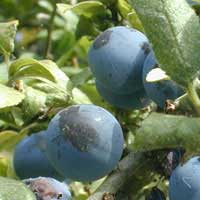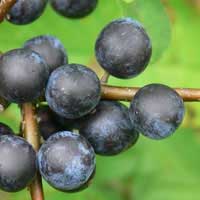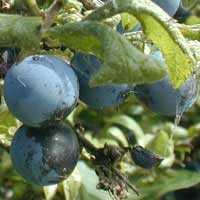 Full List of Fruits
Full List of Fruits  Sloe fruit
Sloe fruitSloe fruit
Scientific name - Prunus spinosa
The Sloe falls under the category of a bigger sized deciduous shrub also the tree is small in the size with a height of 5 meters which is 16 ft. The fruit falls under the drupe category with a diameter of 10-12 milli meters which is 0.39-0.47 in, the color of the fruit is a purple-blue waxy bloom the fruit ripens in the fall and harvested historically in this season but in the UK the harvesting is from October to November following the initial frosts, the pulp has a thin layer and a exhibits a powerful flavor mainly when they are fresh.
The unripe fruits juice helps in making laundry marks, the barks sap provides a sizeable amount of tannins which aids in the manufacture of inks, the braches can be combined together to form many wonderful shapes, they help in the manufacture of walking sticks, the plants wood is apt for the manufacture of fire wood since the burning process is very slow and delivers only feasible amount of smoke. The ripened form of the fruit is known as sloe and aids in the preparation of liqueur known as sloe gin. The fruits also help in preparing jams, jellies, syrups and many more.
The sloe fruit helps in stimulating digestion, also aids in solving the problem of constipation, cures dyspepsia, lessens bloating, heals diarrhea mainly for children. The flowers help in discarding fluid retention and in solving the complications of kidney stones and kidney since they possess diuretic properties,additively the herb helps in curing bladder spasms, also cures the ailments of cramps found in stomach and also nerve pain. The fully ripened fruits flesh is mixed with some more ingredients helps in the preparation of commercial astringent face masks which improvises the beauty, a mix made out of the flowers help in curing the problems of respiratory tract, as the flowers possess expectorant properties that help in combating cold and cough.
These plants are firm bushes which can survive in a bad soil too commonly grows in the Britain's hedgerows, these flowers are the first one to bloom out differentiating from all the plants , the handle the windbreaks effectively and does not bother about the open environments, the young trees can be easily brought up from the already present suckers also with the help of shallow-planted seeds. If the plants are needed as hedges the degree for planting them must be 45 degrees and also divided into two or three rows each in a direction opposite from one another, the maximum height the plant might grow is 4m with a black bark in it and branches are not uniform and all the twiglets finish with thorns.
Sloe fruit can be cultivated from seed or from cuttings. When sowing from seed, the seeds should be planted in the fall and the young plants will bloom in the spring. If the fruit is being propagated from cuttings, the cuttings should be taken from a healthy, disease-free parent plant and then dipped in rooting hormone before being planted into the soil.
Sloe fruit prefers a slightly acidic soil with a pH of 6.5 to 7.5. The soil should also be well draining and have a high organic matter content. Plants should be spaced 1-2 meters apart and should be pruned annually in the fall to encourage fruit production.
Sloe fruit is generally harvested in the fall, after the first frost. The fruit can be eaten fresh, or can be canned, frozen, or made into jam or jelly. Sloe fruit is often used to make a tart liqueur, called sloe gin.
To ensure a healthy crop of sloe fruit, growers should pay attention to water and nutrient needs, as well as pest and disease problems. Weeds should be kept under control and plants should be pruned regularly. Sloe fruit can be a rewarding and delicious addition to any garden.
The harvest period for the fruits are during the end of fall, but avoid harvesting in the first frost else they will taste bitter, if at all the fruits are gathered during first frost they must be stored inside the freezer in the night.
The fruits best storage spot is inside a gin bottle , the fruits must be pricked many times mix the fruit with brown sugar and some almonds and the mixture must be steeped for many months prior to drinking.


















